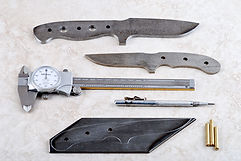



How is a custom knife made?
It may not be Rocket Science, but for me knife making is an Exacting Science! I am constantly Researching, Experimenting, and Testing so that I can either improve my quality or come up with something new. There is no factory- only my little shed in the back of my house and hours of hard labor, pride, and determination.
Custom Knife making is done by hand and eye, similar to throwing a clay pot. Instead of using your fingers to form the size & bowl shape, a powerful 2 x 72 inch belt grinder is used to remove the steel, shape the profile, and form the hollow grind. This process is called Stock Removal.
Your ability to use the naked eye and determine a straight line is paramount. I believe that 40 years of straightening wood arrows has helped me see a Straight Line and make the corrections needed.
- Here is a taste of the basic procedure -
* Starting with raw steel, I shape & drill holes. I grind 80% of the Hollow Grind.
* Combining the belt grinder's flat platen, and a 9 inch disc sander, I create the taper in the grip known as a Tapered Tang.
* I then send the steel off for Cryogenic heat treatment. this gives the steel an extra durability for the edge.
* After Heat treat I carefully finish the flats, and perfect the hollow grind. The High Mirror Polish is achieved by slowly going through the grits (from 60 grit to 1200 grit).
* Then the steel is lightly buffed on a Buffer. I then chemical etch my arrow emblem and add the edge.
Sounds easy eh? It took me three & one half years of 10 hours a day, six days a week and the generous help and knowledge of one of the worlds greatest and most recognized knife makers, D'Alton Holder, to begin to understand the High Mirror Polish.
- Searching the world over for the most beautiful and exotic woods -
Wood is generally purchased green with a high moisture content. I air dry this wood for at least one year or more. After a year's time, when the wood is 80% dry, I then place the wood in my wood dryer for two to three weeks. It is then sealed in plastic and shipped to K & G Stabilizing services. This company has perfected the process of Wood Stabilization.
The wood block is cut in half and turned inside out. The outsides now look the same. This is called Book Matching. I drill holes, rough cut the slabs, and epoxy them on to the tang.
The final process is rounding over the wood so it glides into the hand, eliminating any sharp surfaces.I like to call this final process the AAAH FACTOR
There is that moment of shaping when all of a sudden it just feels right. And you go AAAH
I am slow, and very meticulous, I demand high standards to achieve the results that I want. It takes me approximately 20 to 30 hours to complete one knife and sheath! And about $125 in materials for each knife & sheath.
But that is only the straight labor time. This does not include the clean up, the set up for each step, the searching for rare woods, the one year time it takes to dry the wood properly and then send it in for stabilization. There is also the ordering of supplies, continually searching for rare woods, and Research-Research-Research. If I added up all of those hours, well that must be why I am working all the time!
Generally a Knife maker does not enter into this profession to make lots of money. It can happen, but usually only after many, many years, when the knife maker's knives becomes collectible. Similar to an artist and his paintings.
A knife maker makes knives because he has to! It is not a choice. It is a necessity!
Put simply, a knife cuts deeply into the fabric of a knife makers nature.
Knife making enables me to combine my artistic endeavors with a product that is very useful.






